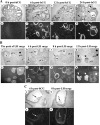RUNX2 transcription factor regulates gene expression in luteinizing granulosa cells of rat ovaries
- PMID: 20197312
- PMCID: PMC2852356
- DOI: 10.1210/me.2009-0392
RUNX2 transcription factor regulates gene expression in luteinizing granulosa cells of rat ovaries
Abstract
The LH surge promotes terminal differentiation of follicular cells to become luteal cells. RUNX2 has been shown to play an important role in cell differentiation, but the regulation of Runx2 expression and its function in the ovary remain to be determined. The present study examined 1) the expression profile of Runx2 and its partner CBFbeta during the periovulatory period, 2) regulatory mechanisms of Runx2 expression, and 3) its potential function in the ovary. Runx2 expression was induced in periovulatory granulosa cells of human and rodent ovaries. RUNX2 and core binding factor-beta (CBFbeta) proteins in nuclear extracts and RUNX2 binding to a consensus binding sequence increased after human chorionic gonadotropin (hCG) administration. This in vivo up-regulation of Runx2 expression was recapitulated in vitro in preovulatory granulosa cells by stimulation with hCG. The hCG-induced Runx2 expression was reduced by antiprogestin (RU486) and EGF-receptor tyrosine kinase inhibitor (AG1478), indicating the involvement of EGF-signaling and progesterone-mediated pathways. We also found that in the C/EBPbeta knockout mouse ovary, Runx2 expression was reduced, indicating C/EBPbeta-mediated expression. Next, the function of RUNX2 was investigated by suppressing Runx2 expression by small interfering RNA in vitro. Runx2 knockdown resulted in reduced levels of mRNA for Rgc32, Ptgds, Fabp6, Mmp13, and Abcb1a genes. Chromatin immunoprecipitation analysis demonstrated the binding of RUNX2 in the promoter region of these genes, suggesting that these genes are direct downstream targets of RUNX2. Collectively, the present data indicate that the LH surge-induced RUNX2 is involved in various aspects of luteal function by directly regulating the expression of diverse luteal genes.
Figures









Similar articles
-
Periovulatory expression of hyaluronan and proteoglycan link protein 1 (Hapln1) in the rat ovary: hormonal regulation and potential function.Mol Endocrinol. 2010 Jun;24(6):1203-17. doi: 10.1210/me.2009-0325. Epub 2010 Mar 25. Mol Endocrinol. 2010. PMID: 20339004 Free PMC article.
-
Response gene to complement 32 expression is induced by the luteinizing hormone (LH) surge and regulated by LH-induced mediators in the rodent ovary.Endocrinology. 2008 Jun;149(6):3025-36. doi: 10.1210/en.2007-1129. Epub 2008 Feb 28. Endocrinology. 2008. PMID: 18308847 Free PMC article.
-
Core Binding Factor-β Knockdown Alters Ovarian Gene Expression and Function in the Mouse.Mol Endocrinol. 2016 Jul;30(7):733-47. doi: 10.1210/me.2015-1312. Epub 2016 May 13. Mol Endocrinol. 2016. PMID: 27176614 Free PMC article.
-
Core Binding Factor β Expression in Ovarian Granulosa Cells Is Essential for Female Fertility.Endocrinology. 2018 May 1;159(5):2094-2109. doi: 10.1210/en.2018-00011. Endocrinology. 2018. PMID: 29554271 Free PMC article.
-
Regulation of luteinizing hormone receptor expression by an RNA binding protein: role of ERK signaling.Indian J Med Res. 2014 Nov;140 Suppl(Suppl 1):S112-9. Indian J Med Res. 2014. PMID: 25673531 Free PMC article. Review.
Cited by
-
Ovulation: Parallels With Inflammatory Processes.Endocr Rev. 2019 Apr 1;40(2):369-416. doi: 10.1210/er.2018-00075. Endocr Rev. 2019. PMID: 30496379 Free PMC article. Review.
-
X-linked lymphocyte regulated gene 5c-like (Xlr5c-like) is a novel target of progesterone action in granulosa cells of periovulatory rat ovaries.Mol Cell Endocrinol. 2015 Sep 5;412:226-38. doi: 10.1016/j.mce.2015.05.008. Epub 2015 May 21. Mol Cell Endocrinol. 2015. PMID: 26004213 Free PMC article.
-
High and low dose of luzindole or 4-phenyl-2-propionamidotetralin (4-P-PDOT) reverse bovine granulosa cell response to melatonin.PeerJ. 2023 Jan 16;11:e14612. doi: 10.7717/peerj.14612. eCollection 2023. PeerJ. 2023. PMID: 36684672 Free PMC article.
-
The Potential of FGF-2 in Craniofacial Bone Tissue Engineering: A Review.Cells. 2021 Apr 17;10(4):932. doi: 10.3390/cells10040932. Cells. 2021. PMID: 33920587 Free PMC article. Review.
-
New insights into the genic and metabolic characteristics of induced pluripotent stem cells from polycystic ovary syndrome women.Stem Cell Res Ther. 2018 Aug 9;9(1):210. doi: 10.1186/s13287-018-0950-x. Stem Cell Res Ther. 2018. PMID: 30092830 Free PMC article.
References
-
- Murphy BD 2000 Models of luteinization. Biol Reprod 63:2–11 - PubMed
-
- Richards JS, Russell DL, Ochsner S, Espey LL 2002 Ovulation: new dimensions and new regulators of the inflammatory-like response. Annu Rev Physiol 64:69–92 - PubMed
-
- Richards JS 2005 Ovulation: new factors that prepare the oocyte for fertilization. Mol Cell Endocrinol 234:75–79 - PubMed
-
- Richards JS 2007 Genetics of ovulation. Semin Reprod Med 25:235–242 - PubMed
-
- Hernandez-Gonzalez I, Gonzalez-Robayna I, Shimada M, Wayne CM, Ochsner SA, White L, Richards JS 2006 Gene expression profiles of cumulus cell oocyte complexes during ovulation reveal cumulus cells express neuronal and immune-related genes: does this expand their role in the ovulation process? Mol Endocrinol 20:1300–1321 - PubMed
Publication types
MeSH terms
Substances
Grants and funding
LinkOut - more resources
Full Text Sources
Molecular Biology Databases
Miscellaneous

